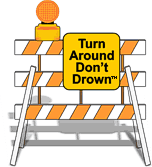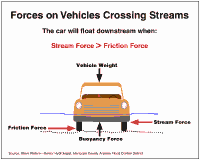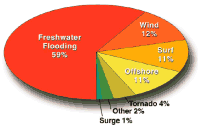 Never Drive Across a Flooded Road! Never Drive Across a Flooded Road!
Whether it is a severe thunderstorm, tropical weather system or a hurricane, heavy rainfall in Florida causes flooding problems.
When a large amount of rain falls over a short period of time, ditches, rivers and lakes become filled with water and overflow into low-lying or poorly drained areas. In addition to the high frequency of excessive rainfall events, the impacts of flooding in Florida may increase as the state's population and urban development grows.
Flood Statistics
Statistics clearly point out the high risk of driving in and around flooded roads and low spots. Usually, individuals between the ages of 30-39 years old attempt to drive through flooded roads only to be wisked away by rushing waters. The rule is simple: if you cannot see the road or its line markings, do not drive through the water.
 Effect of Moving Water on Vehicles Effect of Moving Water on Vehicles
Moving water exerts a pressure on an object such as a car or person. As water depth increases or a greater area is exposed to moving water, a greater force will be exerted. Also, as a surface becomes slippery, friction is reduced. Water, sand, or mud tends to replace the frictional forces that hold a car in place.
Consideration of Sport Utility Vehicles (SUVs)
Even though the weight of Sport Utility Vehicles (SUVs) may appear to offer a greater protection in crossing flooded roads, their size and larger tires can make them more buoyant and more prone to being swept away. Bottom Line: It is just as dangerous to drive an SUV through flooded waters as a regular vehicle.
 Pooling of Water Pooling of Water
Due to the relatively flat terrain across Florida, it is much more complicated to drain accumulated water. When rivers rise, water tends to spread out far from riverbanks. In the case of the 1997-98 El Niño floods, rising rivers and repeated periods of heavy rainfall combined to pool water over land miles away from rivers. In fact, normally small rivers turned into vast lakes.
Pooling of water poses a significant risk, not as much from swift moving water, but more from one's inability to judge water depth. Water only inches deep can be next to water that is several feet deep.
 Tropical Cyclones and Inland Flooding Tropical Cyclones and Inland Flooding
Florida is affected by a large number of tropical weather systems. Although storm surge has the greatest potential for loss of life, recent research indicates that inland flooding is responsible for the greatest number of fatalities over the last 30 years. Studies show that 59 percent of the tropical cyclone deaths in the United States resulted from severe inland flooding.
Urban Flooding
An area of low pressure moving toward the Southwest Florida gulf coast in October 2000 dumped nearly 10-20 inches of rain across southeast Florida. This produced a 10-mile wide swath of urban flooding in Miami-Dade and southeast Broward counties. This system eventually formed into Tropical Storm Leslie off the northeast Florida coast.
In addition to damaged roads and agricultural areas, nearly 93,000 residences or 214,000 persons were flooded or isolated by the urban flood waters. Three persons died as indirect effects of the event- two from drowning by driving vehicles into deep water, and one from a fall.
|